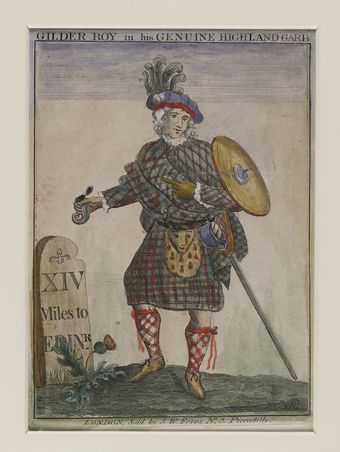Annotation:Gilderoy (1): Difference between revisions
No edit summary |
No edit summary |
||
| (2 intermediate revisions by the same user not shown) | |||
| Line 11: | Line 11: | ||
''He never wore a Highland plad, but costly silken Cloaths.''<br> | ''He never wore a Highland plad, but costly silken Cloaths.''<br> | ||
</blockquote> | </blockquote> | ||
"Gilder Roy" was published by [[biography:Alexander Stuart]]" in his '''Musick for Allan Ramsay’s Collection part 4''' (Edinburgh, c. 1724), a volume of airs to songs in [[wikipedia:Allan Ramsay|Allan Ramsay]]'s '''Tea Table Miscellany'''. A printing of the tune appears in the [James] '''Gillespie Manuscript of Perth''' (1768). The title appears in Henry Robson's list of popular Northumbrian song and dance tunes, which he published c. 1800. The march was also entered into the c. 1776-1778 music copybook of fifer Thomas Nixon Jr. [http://www.framinghamhistory.org/framinghamhistory/Default/exhibit4/e40091b.htm] (1762-1842), of Framingham, Connecticut. Nixon was a thirteen-year-old who accompanied his father to the battles of Lexington and Concord, and who served in the Continental army in engagements in and around New York until 1780, after which he returned home to build a house in Framingham. The copybook appears to have started by another musician, Joseph Long, and to have come into Nixon’s possession. | "Gilder Roy" was published by [[biography:Alexander Stuart|Alexander Stuart]]" in his '''Musick for Allan Ramsay’s Collection part 4''' (Edinburgh, c. 1724), a volume of airs to songs in [[wikipedia:Allan Ramsay (poet)|Allan Ramsay]]'s '''Tea Table Miscellany''' (1724, p. 374<ref>Appearing as "Song, to the tune of Gilder Roy" beginning "Ah! Cloris, cou'd I now but sit, As unconcerned, as when Your Infant Beauty cou'd beget". This means the tune was reasonably well-known to readers of the '''Tea Table Miscellany''', who would be expected to know it for the song</ref>). A printing of the tune appears in the [James] '''Gillespie Manuscript of Perth''' (1768). The title appears in Henry Robson's list of popular Northumbrian song and dance tunes, which he published c. 1800. The march was also entered into the c. 1776-1778 music copybook of fifer Thomas Nixon Jr. [http://www.framinghamhistory.org/framinghamhistory/Default/exhibit4/e40091b.htm] (1762-1842), of Framingham, Connecticut. Nixon was a thirteen-year-old who accompanied his father to the battles of Lexington and Concord, and who served in the Continental army in engagements in and around New York until 1780, after which he returned home to build a house in Framingham. The copybook appears to have started by another musician, Joseph Long, and to have come into Nixon’s possession. | ||
<br> | <br> | ||
<br> | <br> | ||
Latest revision as of 19:02, 25 April 2024
X:1 T:Gilder Roy T:Gilderoy [1] M:C L:1/8 B:Alexander Stuart – “Musick for Allan Ramsay’s Collection part 4” B:(Edinburgh, c. 1724, pp. 94-95) F: https://digital.tcl.sc.edu/digital/collection/rbc/id/3034 Z:AK/Fiddler’s Companion K:Amin V:1 E|A3B (cB)(cd)|e2 dc d2 cd|e2 G2 (cA)(GE)|G3A G2 cB| (A^G)(AB)|(cB)(cd)|e2 dc d2f2|e2 (dc/B/) c2 B>A|A4 A2:| |:ef|g3a (gf)(ed)|(fe)dc d2 cd|e2G2 (cA)(GE)|G3A G2 ef| g3a (gf)(ed)|(fe)(dc) d2 f2|e2 (dc/B/) (cd) B>A|A4 A2:|| V:2 clef = bass z|A,2E,2A,,2 A,B,|C2 B,A, B,2E,2|C,2E,2A,2C,2|G,2D,2G,,2 z2| A,,2E,2A,2E,2|C,2B,,A,, B,,2D,2|C,2D,2E,2E,,2|A,2E,2A,,2:| |:z2|C,2F,2E,2A,2|D,C,B,,A,, G,,2E,2|C,2E,2A,,2C,2|G,,2D,2G,2z2| C,2F,2 E,D,C,B,,|D,C,B,,A,, G,,2D,2|C,2D,2E,2E,,2|A,,2 C,E, A,2:|

Gilderoy was a bonny Boy, had roses tull his shun,
His Stockings made of the finest silk, his Garters hanging down
It was a comely sight to see, he was so trim a Boy,
He was my Joy and Heart's Delight, my handsom Gilderoy.
Oh, sike a charming Eyen he had, a great as sweet as Rose;
He never wore a Highland plad, but costly silken Cloaths.
"Gilder Roy" was published by Alexander Stuart" in his Musick for Allan Ramsay’s Collection part 4 (Edinburgh, c. 1724), a volume of airs to songs in Allan Ramsay's Tea Table Miscellany (1724, p. 374[2]). A printing of the tune appears in the [James] Gillespie Manuscript of Perth (1768). The title appears in Henry Robson's list of popular Northumbrian song and dance tunes, which he published c. 1800. The march was also entered into the c. 1776-1778 music copybook of fifer Thomas Nixon Jr. [1] (1762-1842), of Framingham, Connecticut. Nixon was a thirteen-year-old who accompanied his father to the battles of Lexington and Concord, and who served in the Continental army in engagements in and around New York until 1780, after which he returned home to build a house in Framingham. The copybook appears to have started by another musician, Joseph Long, and to have come into Nixon’s possession.
Bruce Olson includes "Gilderoy [1]" in a large song air and dance tune family that includes "Green Shores of America," "Maria Martin," "Lazarus," "Come all you worthy Christians," "Star of the County Down," "Unquite Grave," "King Herod and the Cock," "Tree in the Wood (The)," "Babe of Bethlehem (The)," "Bonaparte Crossing the Alps," and "Bonaparte's Retreat."
- ↑ Domhnall Uillean Stiùbhart, "Highland rogues and the roots of Highland Romanticism," p. 169 [2].
- ↑ Appearing as "Song, to the tune of Gilder Roy" beginning "Ah! Cloris, cou'd I now but sit, As unconcerned, as when Your Infant Beauty cou'd beget". This means the tune was reasonably well-known to readers of the Tea Table Miscellany, who would be expected to know it for the song

